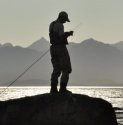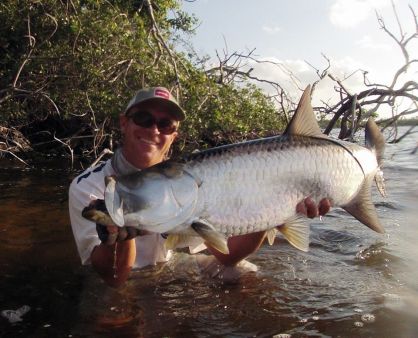Fd: How did the Alphonse experience start for you?
Keith: I fished Alphonse and St. François many years ago before there was a hotel on Alphonse. The diversity of the destination and magnificent reputation of how well the fishery has been managed allowing for it to be as wild and pristine as it is today. I have had an incredible affection for Milkfishing and there is no better place on this planet to target these finicky and difficult species. So when the opportunity arose for “Alphonse Fishing Co.” to purchase Alphonse there were no hesitations.
Fd: What can you tell us from this incredible destination in the Seychelles?
Keith: The beauty of Alphonse is that you fish St. Francois, which is uninhabited, frozen in time and teeming with fish. Here is a little info about the destination: 292 miles southwest of Mahe lies the St François Lagoon and adjacent Alphonse Island, part of the Amirantes group of Islands. Alphonse is the one of the famed saltwater destinations of the Indian Ocean and perhaps home to the most prolific Bone fishery in the world. In addition to the abundant bonefish (ranging in size from 3 – 8 lbs) there are three species of Trigger fish, five species of Trevally and a plethora of other flats and offshore species. Perhaps the most challenging fish to catch is the fabled Milkfish; a turbo charged algae eater growing to 40lbs. The guides on Alphonse Island have pioneered techniques which have allowed these vegetarian and notoriously difficult fish to be caught. This diversity gives the angler the opportunity to target a myriad of different species during the course of one trip. The bluewater fly fishing is equally impressive with Sailfish.
Fd: What can one expect about GTs on the fly?
Keith: They are ferocious, tackle busters that will find any weak point in your tackle setup. The take can be explosive or slow and calculated. There is no more exciting take that when a Giant comes towards you, sticks its big black dilated eyes out the water, and engulfs the fly with a bucket sized mount. I fish a 12weight G-Loomis NRX and a Shilton SL7, loaded with 400 yards of 80lbs braided backing, connected by a Bimini-twist to double surgeon and 2 x 50lbs braided loops, which are nail knotted onto the fly line.
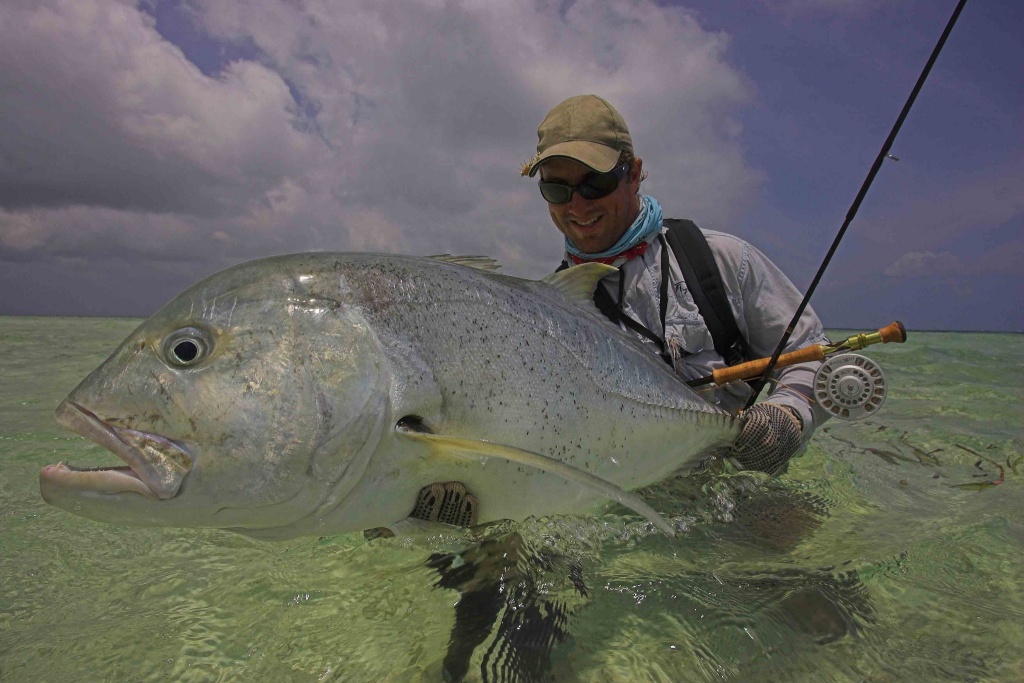 Fd: And what would be the recommended gear for the whole trip?
Fd: And what would be the recommended gear for the whole trip?
Keith:
Bonefish & Permit
2 x 9-foot 8 or 9-weight fly rod (1 x Spare)
1 x High quality large arbour saltwater series reel, with a strong smooth drag to match the 9-weight fly rod. Load the reel with two to three hundred yards of 60lbs braid
1 x High quality weight forward 8 or 9-weight tropical floating line, suitable for warm water conditions.
Triggerfish & Milkfish
1 x 9-foot 10-weight fly rod
1 x High quality large arbour saltwater series reel, with a strong smooth drag to match the 9-weight fly rod. Load the reel with three hundred yards of 60lbs braid
1 x High quality weight forward 10-weight tropical floating line, suitable for warm water conditions.
Giant Trevally, Bluefin Trevally, Barracuda & Bluewater
2 x 9-foot 12-weight fly rod (1 x Spare)
1 x High quality large arbour saltwater series reel, with a strong smooth drag to match the 12-weight fly rod. The reel should be loaded with three hundred yards of 80lbs braid
1 x High quality heavy weight forward 12-weight tropical floating line, suitable for warm water conditions
Terminal Tackle
3 x 9-foot 22lb saltwater tapered leaders
1 x 15lb or 17lbs fluorocarbon tippet material
1 x 20lb fluorocarbon tippet material
1 x 130lbs Suffix Zippy Soft Mono
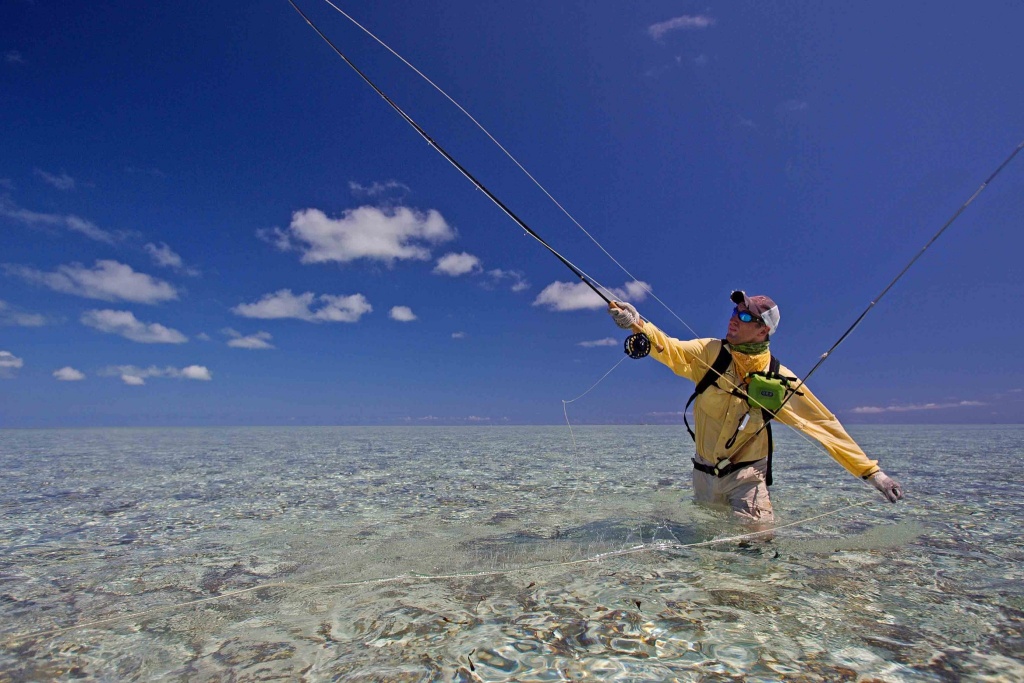 Fd: What about the flies?
Fd: What about the flies?
Keith: It is critical that all anglers carry a complete selection of flies tied the correct way with the correct materials and on the correct hooks. We recommend the following fly selection, which will cover all your fishing. There is a really good selection of flies, which are specific to Astove that can be purchased when on location.
Bonefish
Gotchas #6
Christmas Island Special (Orange) #6
Pillow Talks # 6
Spawning Shrimp #6
Fleeing Crab Cream/Tan #8
Permit & Triggerfish
James’s Sand Prawn #2
James’s Sand Prawn #4
Fleeing Crab Cream/Tan – Orange Legs #2
Yousie Velcro Crab #2
Milkfish
Milkydream Chartreuse #2
Milkydream Olive Rams Wool #2
Giant Trevally, Bluefin Trevally & Barracuda
GT Brush Fly (Tan) #6/0
GT Brush Fly (Black) #6/0
GT Brush Fly (Black & Purple) #6/0
Not Your Average Popper (NYAP) #6/0
Bluewater & Billfish
Deep-throat Dredging Flies #8/0 x 2
Pink, White & Purple Cam Seglar Sailfish Tube Tandem #8/0 x 2
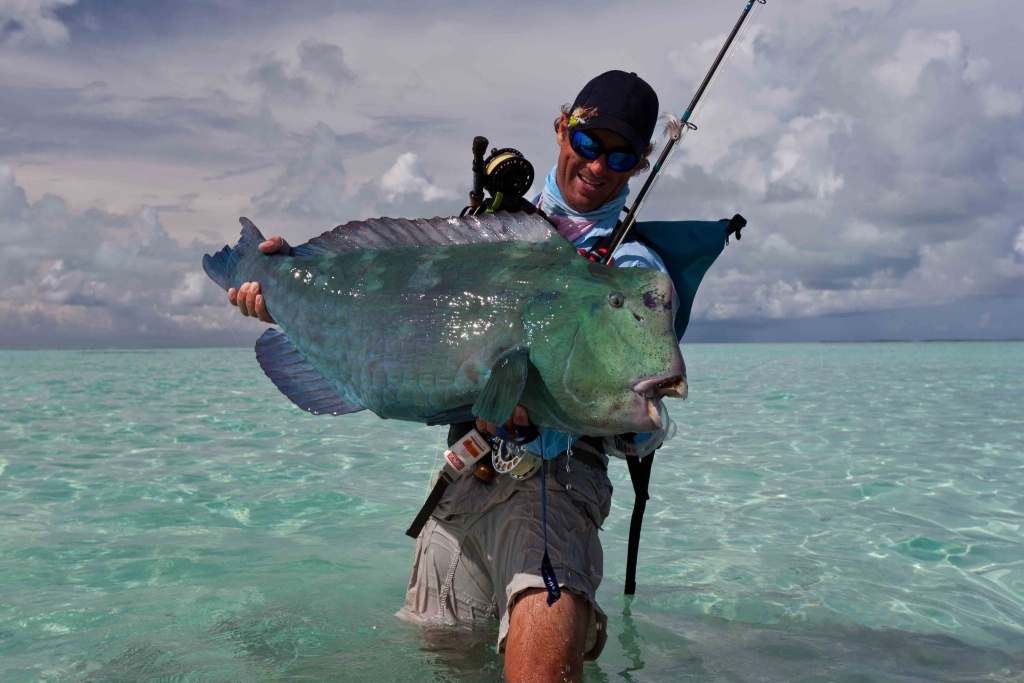 Fd: How’s a typical day out fly fishing in Alphonse Island?
Fd: How’s a typical day out fly fishing in Alphonse Island?
Keith: Breakfast is served from 6:00 am onwards so most guests opt for an early morning wake-up call around 5:45 am and start breakfast at 6:15 am. All anglers meet at the fishing office at 6:45 am every morning and once all anglers have assembled, you will be ferried to the mother ship and commence with the 40 minute trip to the mooring in St Francois lagoon, where the skiffs are kept.
The teams consisting of anglers and 1 guide will then be transferred to their relevant skiff for the 8 hour fishing session. Lunch is taken either on the mother ship or on the individual skiffs, depending on your preference. All the skiffs will have cooler boxes with ice, drinks and desalinated water in aluminum bottles. Lunch packs will be taken onto the skiffs unless otherwise requested.
At 4:00 pm the guides will start returning to the mother ship and for safety reasons everyone needs to be on board the vessel by 5:00 pm. There will be a fresh water buckets provided to rinse your reels and gear at the end of each fishing day. Once everything is squared away the mother ship will start the 40-minute journey back to the mooring at Alphonse Island. Unless needed for extra fishing on Alphonse, your rods, tackle and gear can stay on the mother ship so it’s ready for the next day.
The Alphonse group is one of the most famed saltwater fly fishing destinations in the Indian Ocean and is one of the most prolific Bonefish fisheries in the world. St Francois is approximately 7 miles long and 4 miles wide, consisting of firm white sand bottoms interlaced with channels and cuts.
The maximum number of anglers that are allowed to fish St Francois is limited to 12 per day. The uniqueness that sets St Francois apart from many other saltwater destinations is the ability to wade over 10 000 acres of hard white sand flats in search of the various species on offer.
A typical fishing session will involve wading away from the skiff for a few hours. Bonefish wades will involve either fishing to cruising or tailing fish as they forage for crustaceans. On falling tides it is often the case that huge shoals of Bonefish can be targeted when leaving the flats in what has been described as a continuous river of Bonefish. Whether you’re after tailing singles and doubles or shoals, the guides have the ability to make it happen. St Francois is rumored to have the densest population of Bonefish recorded worldwide. Some flats support larger Bonefish specimens than others and a fair lagoon average would be about 4lbs. The largest Bonefish caught to date was a whopping 9.5 pounds. The average catch returns over the last 3 years are 12 - 15 Bonefish per person per day and depending on the angler’s skill often many, many more!
 It is not uncommon for good fly anglers to land 20-40 fish days in succession. In addition to the abundant Bonefish flats, the lagoon envelopes coral finger flats and coral heads allowing anglers to catch several of the now 60 species targeted on fly, including 3 species of Triggerfish, 7 species of Trevally, Milkfish, Barracuda, Sailfish, Dogtooth Tuna, Yellowfin Tuna and a plethora of other flats and offshore species. Sight fishing for Giant Trevally is one of the most exhilarating forms of fly fishing one will ever experience, especially when they grow in excess of 150lbs. At certain times of the year, Milkfish feed on plankton near the surface and are then enticed to eat flies.
It is not uncommon for good fly anglers to land 20-40 fish days in succession. In addition to the abundant Bonefish flats, the lagoon envelopes coral finger flats and coral heads allowing anglers to catch several of the now 60 species targeted on fly, including 3 species of Triggerfish, 7 species of Trevally, Milkfish, Barracuda, Sailfish, Dogtooth Tuna, Yellowfin Tuna and a plethora of other flats and offshore species. Sight fishing for Giant Trevally is one of the most exhilarating forms of fly fishing one will ever experience, especially when they grow in excess of 150lbs. At certain times of the year, Milkfish feed on plankton near the surface and are then enticed to eat flies.
Alphonse is where the “Milkfish on fly dream” began and these speedy, high flying fish, which have been caught up to 40 pounds, entertain our guests every season. The fishing is very much tide dependent so the prevailing conditions will dictate which species you will focus on. The factors controlling numbers of fish caught are weather, timing of the tides and, perhaps most importantly, skill and the decision to go for size or quantity.
Fd: Apart from the fishing, how’s life for a guide in this operation?
Keith: It’s tough work as the guides start at 05h30 and work 6 days a week for 8 months. The sun beats your body up and handling big fish takes a toll on your hands. The Seychelles is probably the most technical saltwater destination as there are so many species which require different techniques. This variety is what keeps you driven and entertained as a guide.
Fd: About photography. How did you get started and how did you combine it with fly fishing?
Keith: I have been guiding in the Seychelles for 17 years and concentrated on marketing and inserting this magnificent place into many fly anglers diary. In the past I ran various fishing businesses that required marketing the Seychelles atolls and its fly fishing, so it was a natural progression to take up photography. Along with my art director qualification it helped drastically in my career migration from a guide to the position which I hold in Alphonse Fishing Co.
The main reason was to capture the amazing situations which we find ourselves experiencing almost on a daily basis when out on the Seychelles flats. Some of our other destinations like Astove and Cosmoledo are as wild as you will get anywhere, and you see things that you will not see anywhere else. It’s these situations that demand a camera so you can freeze it in time for you to remember after many years have passed by.
Find more info about these destination in Keith's profile.
Keith: I fished Alphonse and St. François many years ago before there was a hotel on Alphonse. The diversity of the destination and magnificent reputation of how well the fishery has been managed allowing for it to be as wild and pristine as it is today. I have had an incredible affection for Milkfishing and there is no better place on this planet to target these finicky and difficult species. So when the opportunity arose for “Alphonse Fishing Co.” to purchase Alphonse there were no hesitations.
Fd: What can you tell us from this incredible destination in the Seychelles?
Keith: The beauty of Alphonse is that you fish St. Francois, which is uninhabited, frozen in time and teeming with fish. Here is a little info about the destination: 292 miles southwest of Mahe lies the St François Lagoon and adjacent Alphonse Island, part of the Amirantes group of Islands. Alphonse is the one of the famed saltwater destinations of the Indian Ocean and perhaps home to the most prolific Bone fishery in the world. In addition to the abundant bonefish (ranging in size from 3 – 8 lbs) there are three species of Trigger fish, five species of Trevally and a plethora of other flats and offshore species. Perhaps the most challenging fish to catch is the fabled Milkfish; a turbo charged algae eater growing to 40lbs. The guides on Alphonse Island have pioneered techniques which have allowed these vegetarian and notoriously difficult fish to be caught. This diversity gives the angler the opportunity to target a myriad of different species during the course of one trip. The bluewater fly fishing is equally impressive with Sailfish.
Fd: What can one expect about GTs on the fly?
Keith: They are ferocious, tackle busters that will find any weak point in your tackle setup. The take can be explosive or slow and calculated. There is no more exciting take that when a Giant comes towards you, sticks its big black dilated eyes out the water, and engulfs the fly with a bucket sized mount. I fish a 12weight G-Loomis NRX and a Shilton SL7, loaded with 400 yards of 80lbs braided backing, connected by a Bimini-twist to double surgeon and 2 x 50lbs braided loops, which are nail knotted onto the fly line.
 Fd: And what would be the recommended gear for the whole trip?
Fd: And what would be the recommended gear for the whole trip?Keith:
Bonefish & Permit
2 x 9-foot 8 or 9-weight fly rod (1 x Spare)
1 x High quality large arbour saltwater series reel, with a strong smooth drag to match the 9-weight fly rod. Load the reel with two to three hundred yards of 60lbs braid
1 x High quality weight forward 8 or 9-weight tropical floating line, suitable for warm water conditions.
Triggerfish & Milkfish
1 x 9-foot 10-weight fly rod
1 x High quality large arbour saltwater series reel, with a strong smooth drag to match the 9-weight fly rod. Load the reel with three hundred yards of 60lbs braid
1 x High quality weight forward 10-weight tropical floating line, suitable for warm water conditions.
Giant Trevally, Bluefin Trevally, Barracuda & Bluewater
2 x 9-foot 12-weight fly rod (1 x Spare)
1 x High quality large arbour saltwater series reel, with a strong smooth drag to match the 12-weight fly rod. The reel should be loaded with three hundred yards of 80lbs braid
1 x High quality heavy weight forward 12-weight tropical floating line, suitable for warm water conditions
Terminal Tackle
3 x 9-foot 22lb saltwater tapered leaders
1 x 15lb or 17lbs fluorocarbon tippet material
1 x 20lb fluorocarbon tippet material
1 x 130lbs Suffix Zippy Soft Mono
 Fd: What about the flies?
Fd: What about the flies?Keith: It is critical that all anglers carry a complete selection of flies tied the correct way with the correct materials and on the correct hooks. We recommend the following fly selection, which will cover all your fishing. There is a really good selection of flies, which are specific to Astove that can be purchased when on location.
Bonefish
Gotchas #6
Christmas Island Special (Orange) #6
Pillow Talks # 6
Spawning Shrimp #6
Fleeing Crab Cream/Tan #8
Permit & Triggerfish
James’s Sand Prawn #2
James’s Sand Prawn #4
Fleeing Crab Cream/Tan – Orange Legs #2
Yousie Velcro Crab #2
Milkfish
Milkydream Chartreuse #2
Milkydream Olive Rams Wool #2
Giant Trevally, Bluefin Trevally & Barracuda
GT Brush Fly (Tan) #6/0
GT Brush Fly (Black) #6/0
GT Brush Fly (Black & Purple) #6/0
Not Your Average Popper (NYAP) #6/0
Bluewater & Billfish
Deep-throat Dredging Flies #8/0 x 2
Pink, White & Purple Cam Seglar Sailfish Tube Tandem #8/0 x 2
 Fd: How’s a typical day out fly fishing in Alphonse Island?
Fd: How’s a typical day out fly fishing in Alphonse Island?Keith: Breakfast is served from 6:00 am onwards so most guests opt for an early morning wake-up call around 5:45 am and start breakfast at 6:15 am. All anglers meet at the fishing office at 6:45 am every morning and once all anglers have assembled, you will be ferried to the mother ship and commence with the 40 minute trip to the mooring in St Francois lagoon, where the skiffs are kept.
The teams consisting of anglers and 1 guide will then be transferred to their relevant skiff for the 8 hour fishing session. Lunch is taken either on the mother ship or on the individual skiffs, depending on your preference. All the skiffs will have cooler boxes with ice, drinks and desalinated water in aluminum bottles. Lunch packs will be taken onto the skiffs unless otherwise requested.
At 4:00 pm the guides will start returning to the mother ship and for safety reasons everyone needs to be on board the vessel by 5:00 pm. There will be a fresh water buckets provided to rinse your reels and gear at the end of each fishing day. Once everything is squared away the mother ship will start the 40-minute journey back to the mooring at Alphonse Island. Unless needed for extra fishing on Alphonse, your rods, tackle and gear can stay on the mother ship so it’s ready for the next day.
The Alphonse group is one of the most famed saltwater fly fishing destinations in the Indian Ocean and is one of the most prolific Bonefish fisheries in the world. St Francois is approximately 7 miles long and 4 miles wide, consisting of firm white sand bottoms interlaced with channels and cuts.
The maximum number of anglers that are allowed to fish St Francois is limited to 12 per day. The uniqueness that sets St Francois apart from many other saltwater destinations is the ability to wade over 10 000 acres of hard white sand flats in search of the various species on offer.
A typical fishing session will involve wading away from the skiff for a few hours. Bonefish wades will involve either fishing to cruising or tailing fish as they forage for crustaceans. On falling tides it is often the case that huge shoals of Bonefish can be targeted when leaving the flats in what has been described as a continuous river of Bonefish. Whether you’re after tailing singles and doubles or shoals, the guides have the ability to make it happen. St Francois is rumored to have the densest population of Bonefish recorded worldwide. Some flats support larger Bonefish specimens than others and a fair lagoon average would be about 4lbs. The largest Bonefish caught to date was a whopping 9.5 pounds. The average catch returns over the last 3 years are 12 - 15 Bonefish per person per day and depending on the angler’s skill often many, many more!
 It is not uncommon for good fly anglers to land 20-40 fish days in succession. In addition to the abundant Bonefish flats, the lagoon envelopes coral finger flats and coral heads allowing anglers to catch several of the now 60 species targeted on fly, including 3 species of Triggerfish, 7 species of Trevally, Milkfish, Barracuda, Sailfish, Dogtooth Tuna, Yellowfin Tuna and a plethora of other flats and offshore species. Sight fishing for Giant Trevally is one of the most exhilarating forms of fly fishing one will ever experience, especially when they grow in excess of 150lbs. At certain times of the year, Milkfish feed on plankton near the surface and are then enticed to eat flies.
It is not uncommon for good fly anglers to land 20-40 fish days in succession. In addition to the abundant Bonefish flats, the lagoon envelopes coral finger flats and coral heads allowing anglers to catch several of the now 60 species targeted on fly, including 3 species of Triggerfish, 7 species of Trevally, Milkfish, Barracuda, Sailfish, Dogtooth Tuna, Yellowfin Tuna and a plethora of other flats and offshore species. Sight fishing for Giant Trevally is one of the most exhilarating forms of fly fishing one will ever experience, especially when they grow in excess of 150lbs. At certain times of the year, Milkfish feed on plankton near the surface and are then enticed to eat flies.Alphonse is where the “Milkfish on fly dream” began and these speedy, high flying fish, which have been caught up to 40 pounds, entertain our guests every season. The fishing is very much tide dependent so the prevailing conditions will dictate which species you will focus on. The factors controlling numbers of fish caught are weather, timing of the tides and, perhaps most importantly, skill and the decision to go for size or quantity.
Fd: Apart from the fishing, how’s life for a guide in this operation?
Keith: It’s tough work as the guides start at 05h30 and work 6 days a week for 8 months. The sun beats your body up and handling big fish takes a toll on your hands. The Seychelles is probably the most technical saltwater destination as there are so many species which require different techniques. This variety is what keeps you driven and entertained as a guide.
Fd: About photography. How did you get started and how did you combine it with fly fishing?
Keith: I have been guiding in the Seychelles for 17 years and concentrated on marketing and inserting this magnificent place into many fly anglers diary. In the past I ran various fishing businesses that required marketing the Seychelles atolls and its fly fishing, so it was a natural progression to take up photography. Along with my art director qualification it helped drastically in my career migration from a guide to the position which I hold in Alphonse Fishing Co.
The main reason was to capture the amazing situations which we find ourselves experiencing almost on a daily basis when out on the Seychelles flats. Some of our other destinations like Astove and Cosmoledo are as wild as you will get anywhere, and you see things that you will not see anywhere else. It’s these situations that demand a camera so you can freeze it in time for you to remember after many years have passed by.
Find more info about these destination in Keith's profile.

